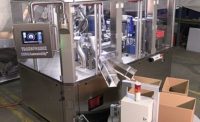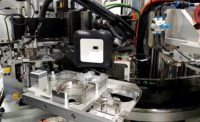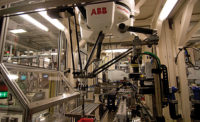Industry 4.0 concepts necessitate highly flexible and modular production equipment. A good example is the new CresaLine small-parts assembly system from Swiss machine builder and integrator Credimex AG.
The CresaLine is a modular automation platform for flexible production. It consists of a standardized chassis and interchangeable, preconfigured processing stations. Each station is equipped with its own computer control system, so it can operate independently. As a result, stations can be added, rearranged or reused as production needs change. Product variants can be assembled on the same line with minimal changeover.
Stations operate independently of the chassis, so individual processes can be automated without having to build out the entire system. This also enables engineers to develop assembly processes for new products while the CresaLine system continues to produce existing ones.
The standard chassis accommodates eight processing stations. Stations are available for a range of processes, including soldering, welding, pressing, adhesive dispensing, plasma treatment, lubrication, pick-and-place, packaging, and test and inspection. Customer-specific stations can also be added, depending on requirements.
The system’s flexibility is made possible by the eXtended Transport System (XTS) from Beckhoff Automation, an intelligent, linear-motor conveyor system that links the various processing stations.
“The modularity of the machine gives you the possibility to produce different products efficiently. The big advantage is that you can automate difficult and complex processes that previously had to be carried out manually,” says Roger Schelbert, co-owner of Credimex and head of the motion technology department. “A wide range of standard processing stations are available for the CresaLine. Pick-and-place, assembly and test stations can thus be integrated as desired.
“These stations are linked by the XTS from Beckhoff,” he continues. “Workpiece carriers with a length of 250 millimeters and a maximum width of 70 to 90 millimeters are mounted on the XTS movers. One or more assemblies can be processed on each carrier. That makes the system very flexible and appealing to various industries, including watchmakers, electronics assemblers, motor manufacturers and medical device manufacturers. What is particularly advantageous is that batch sizes of one can be produced with rapid changeovers for new products.”
PC-based control technology from Beckhoff also plays a key role in providing flexibility and modularity. “PC-based control provides openness and a variety of interfaces for integrating additional components or stations,” he says. “The integration of robotics, for example, is very simple with Beckhoff’s TwinCAT software. In addition, high-performance EtherCAT communication and integrated safety technology with TwinSAFE are available.”
Flexible Layout
The XTS provides flexibility in motion control, not just by replacing mechanical components, but also through software functionality. On the CresaLine system, the XTS is made up of nine 250-millimeter-long linear motor modules. Nine 250-millimeter-long movers move along this track as workpiece carriers. (A smaller chassis, the CresaLine Starter, is half that size.) The system configuration is easy to adapt to the user’s needs: Application-specific movers use the magnetic plate and encoder system from the XTS and the customer’s own guide rail.
In the Credimex system, the XTS is implemented as a linear design rather than a loop.
“On the CresaLine Starter, the movers are lowered at the end of the XTS section and returned to the start via a three-axis linear system,” Schelbert explains. “In the larger CresaLine, the movers are shifted onto an opposite, parallel XTS transfer line by means of a cross-transfer system. The return section is thus also used for assembly stations. This way we can design a very compact system.”
According to Schelbert, the system is easy to extend. “As a result of the modularity in hardware and software, other machine layouts can also be realized with XTS with limited effort, simply through configuration,” he says. “For example, the mover return section under the processing table can be replaced by a cross-transfer or closed XTS system to integrate additional processing stations.”
Traditionally, high-speed indexing chassis move carriers on a fixed pitch at a fixed cycle time. With these systems, all stations operate at the same cycle time. Linear motor conveyors break this paradigm, enabling independent control over the speed, acceleration and trajectory of each workpiece carrier. As a result, engineers can accommodate processes with different speeds—pick-and-place and leak testing, for example—on the same line.
The linear motors position carriers accurately and repeatably, so there’s no need for additional hardware, such as conveyor stops. In addition, the linear motors operate quietly and are practically maintenance-free.
Software Replaces Hardware
Motion functions that would often necessitate expenditure on hardware are readily available with XTS through TwinCAT automation software. “The production flow can be adapted to the addition of process stations by software configuration with no hardware changes at all,” explains Schelbert. “In addition, motion and positioning can be controlled so precisely that hardware components that used to be necessary can be omitted. For instance, with XTS it is no longer necessary to lift the workpiece off a conventional conveyor belt to achieve accurate positioning for processing. As a result, simpler processing stations with fewer motion axes can be realized.”
With the assembly of small parts, in particular, many factors play a role in attaining the desired precision. Even slight vibrations can cause problems. The XTS system minimizes such problems.
“The transfer system works completely independently and without a mechanical connection to the individual process stations,” says Schelbert. “This means that vibrations—for example, due to the return movement of a handling robot—cannot be transmitted to the XTS and thus to other stations. This has a significant positive effect on processing accuracy.”
The flexibility of the movers is also a plus. “The movers can be designed specifically for the application—shorter or longer, larger or smaller—depending on how much space is available or how many individual products must be transported per mover,” Schelbert explains. “So far, we have been concentrating on the micro-assembly area, which extends from 500 microchips up to three or four large components per workpiece carrier.
“However, flexibility also means that individual movers can be removed from the transfer system and put back in again as required. One example is a special mover with a battery-powered camera system that, if necessary, drives through the process, checks the accuracy of the individual process stations, and saves the offset corrections to ensure high precision. This is important for, among other functions, monitoring large temperature differences, such as in the morning or in the middle of the workday.”
Variability and Industry 4.0
The CresaLine meets the requirements of Industry 4.0. For instance, the system’s production efficiency is traceable at any time and for each process, since the individual operations are saved in a database with a time stamp. The main requirement, however, is the modular machine approach based on individual intelligent process stations that are linked via the XTS.
“Entirely in keeping with lot-size-one manufacturing, an order-related decision is made for each project to determine which process steps are necessary for manufacturing,” Schelbert says. “On the one hand, this is made possible by the linking a Beckhoff C6920 central control computer and CX5020 embedded PCs in the individual process modules to the customer’s ERP system.
“On the other hand, a big part is played by individual control over each mover. In this manner, the product to be processed becomes virtually intelligent and can guide itself through the assembly process. A further aspect has to do with the camera mover for calibrating the entire process chain. Its information can be used directly for early corrections of the process sequences before quality defects or excessive part rejects occur.”
For more information, call Beckhoff Automation at 877-TwinCAT or visit www.beckhoffautomation.com.





